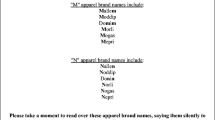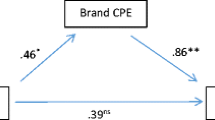Abstract
Recent research has demonstrated that brand name sounds can influence consumer behavior. Sound symbolism, the link between sound and meaning, can convey product information, enhance affinity, and increase purchase intentions. This study examines sound patterns of Interbrand top 100 brand names, including three previously unexamined sound categories. Results show that top brand names have different sound patterns than general brand names. The pattern of differences suggests that sound symbolism may be one factor contributing to brand performance. Sounds more frequent among top brand names have potentially brand enhancing properties, while sounds less frequent may have the opposite effect. These findings should inform best naming practices and strategies.







Similar content being viewed by others
Notes
We use the 95 million words COCA magazine database which references almost 100 popular magazines such as Time, Men’s Health, Good Housekeeping, Cosmopolitan, and Sports Illustrated for the years 1990–2012 (Davies 2008). The database draws from publications in a wide variety of domains such as news, health, home and gardening, women's, financial, religion, and sports, resulting in a balanced portrayal of the English language.
The coding of these brand names and the benchmark dataset is available from the first author upon request.
One brand name (Gap) was discarded because its frequency could not be determined since it is indistinguishable from the common noun “gap.”
References
Aaker, D. A., & Keller, K. L. (1990). Consumer evaluations and brand extensions. Journal of Marketing, 54(January), 27–41.
Allen, C. T., Fournier, S., & Miller, F. (2008). Brands and their meaning makers. In C. Haugtvedt, P. Herr, & F. Kardes (Eds.), Handbook of consumer psychology (pp. 781–822). New York: Psychology Press.
Argo, J., Popa, M., & Smith, M. C. (2010). The sound of brands. Journal of Marketing, 74(4), 97–109.
Bolinger, D. L. (1950). Rime, assonance, and morpheme analysis. Word, 6, 117–136.
Cortese, M. J. (1998). Revisiting serial position effects in reading. Journal of Memory and Language, 3(9), 652–665.
Coulter, K. S., & Coulter, R. A. (2010). Small sounds, big deals: phonetic symbolism effects in pricing. Journal of Consumer Research, 37(2), 315–328.
Davies, M. (2008). The Corpus of Contemporary American English: 450 million words, 1990-present. http://corpus.byu.edu/coca/. Accessed 24 Mar 2014.
Davies, M. (2009). The 385+ million word corpus of contemporary American English (19902008+): Design, architecture, and linguistic insights. International Journal of Corpus Linguistics, 14(2), 159–190.
De Klerk, V., & Bosch, B. (1997). The sound patterns of English nicknames. Language Sciences, 19(4), 289–301.
Dunn, O. J. (1961). Multiple comparisons among means. Journal of the American Statistical Association, 56, 52–64.
Erlich, J. (1995). Giving drugs a good name, The New York Times Magazine, September 3, 36–37.
Fromkin, V., Rodman, R., & Hyams, N. (2010). An introduction to language (9th ed.). Boston: Wadsworth.
Hartley, R. F. (1992). Marketing mistakes (5th ed.). New York: John Wiley & Sons.
Heath, D. & Heath, C. (2011). How to pick the perfect brand name, Fast Company, January 3.
Hinton, L., Nichols, J., & Ohala, J. (Eds.). (1994). Sound symbolism. Cambridge: Cambridge University Press.
Hoffman, G. (2008). New car names - how they get 'em, CNN, March 7.
Interbrand (2011). Methodology. Accessed 20 Oct 2011. http://www.interbrand.com. Accessed 24 Mar 2014.
Jenkins, J. J., Russell, W. A., & Suci, G. J. (1958). An atlas of semantic profiles for 360 words. The American Journal of Psychology, 71(4), 688–699.
Jespersen, O. (1922). Language: its nature, development and origin. London: Allen & Unwin.
Johnson, R. C., Suzuki, N. S., & Olds, W. K. (1964). Phonetic symbolism in an artificial language. Journal of Abnormal and Social Psychology, 69(2), 233–236.
Klink, R. R. (2000). Creating brand names with meaning: the use of sound symbolism. Marketing Letters, 11(1), 5–20.
Klink, R. R. (2001). Creating meaningful new brand names: a study of semantics and sound symbolism. Journal of Marketing Theory and Practice, 9(2), 27–34.
Klink, R. R. (2003). Creating meaningful brands: the relationship between brand name and brand mark. Marketing Letters, 14(3), 143–157.
Klink, R. R. (2009). Gender differences in new brand name response. Marketing Letters, 20(3), 313–326.
Klink, R. R. & Wu, L. (2013). The role of position, type and combination of sound symbolism imbeds in brand names. Marketing Letters.
Köhler, W. (1929). Gestalt psychology. New York: Liveright.
Lewis, P. (ed.). (2009). Ethnologue: Languages of the World, Sixteenth edition. Dallas, Tex.: SIL International. http://www.ethnologue.com. Accessed 24 Mar 2014.
Lowrey, T. M., & Shrum, L. J. (2007). Phonetic symbolism and brand name preference. Journal of Consumer Research, 34, 406–414.
Lowrey, T. M., Shrum, L. J., & Dubitsky, T. M. (2003). The relation between brand-name linguistic characteristics and brand-name memory. Journal of Advertising, 32(3), 7–17.
Maurer, D., Pathman, T., & Mondloch, C. J. (2006). The shape of boubas: Sound-shape correspondences in toddlers and adults. Developmental Science, 9(3), 316–322.
Plato. (1985). In E. Hamilton & H. Cairns (Eds.), The collected dialogues of plato including the letters. Princeton: Princeton University Press.
Schloss, I. (1981). Chickens and pickles. Journal of Advertising Research, 21, 47–49.
Smith, G. W. (1998). The political impact of name sounds. Communication Monographs, 65(2), 154–172.
U.S. Patent and Trademark website accessed 4/19/2012. http://www.uspto.gov/dashboards/trademarks/main.dashxml. Accessed 24 Mar 2014.
Vanden Bergh, B. (1990). The rekurring kase of the special K. Journal of Advertising Research, 30(5), RC9–RC12.
Vanden Bergh, B., Adler, K., & Oliver, L. (1987). Linguistic distinction among top brand names. Journal of Advertising Research, 27(4), 39–44.
Yorkston, E., & Menon, G. (2004). A sound idea: Phonetic effects of brand names on consumer judgments. Journal of Consumer Research, 31(1), 43–51.
Acknowledgement
Many thanks to James Kellaris, Jakki Mohr, and Mary Steffel for their feedback, Jackelyn Torres Van Buren, Kelsey Fanning, and Julie Workman-Hank for their assistance with data analysis, Joel Steckel for his editorial guidance, and the anonymous reviewers for their valuable comments.
Author information
Authors and Affiliations
Corresponding author
Appendix
Appendix
Rights and permissions
About this article
Cite this article
Pogacar, R., Plant, E., Rosulek, L.F. et al. Sounds good: Phonetic sound patterns in top brand names. Mark Lett 26, 549–563 (2015). https://doi.org/10.1007/s11002-014-9288-z
Published:
Issue Date:
DOI: https://doi.org/10.1007/s11002-014-9288-z




